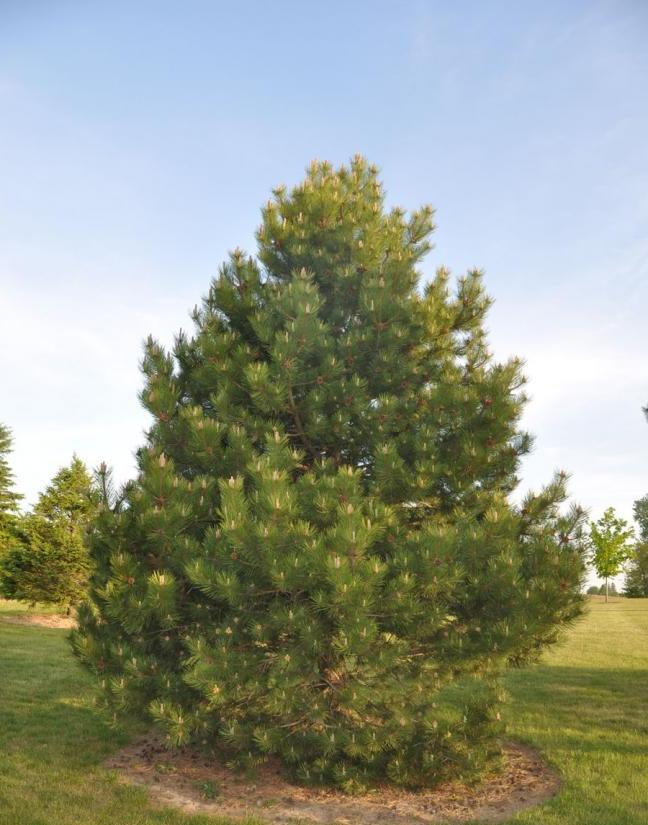by Ken Lain, the mountain gardener

Austrain Pine is resilient in poor mountain soils where alkaline conditions persist. It is remarkably tolerant of hot and cold wind and is a crucial component in privacy and windbreaks. Adapts well to dry conditions in the West, both in semi-desert and mountain foothill regions where soils are thin and skimpy. Makes a graceful single specimen for front yards, parks, or expansive estate-sized landscapes.
A fast growing for pines with 18″ inches of grow expected when happy. A handsome evergreen tree with densely branched conical form when young, becomes umbrella-shaped with age. Needles are long and dark green. Superb for windbreaks or specimen.
A Pine that withstands challenging urban conditions, such as pollution and salt spray. The bark on a mature tree consists of dark brown or gray furrowed plates. Each fascicle has two dark-green needles 3-6 inches long, and the brown egg-shaped cones are 2 inches long.
Botanical Name Pinus Nigra
Common Name Austrian Pine, European Black Pine, Oregan Green Pine
Plant Type Conifer; prized for foliage
Mature Size 40′ feet X 20′ feet spread
Sun Exposure 4+ hours Full sun
Soil Type well-drained soil
Soil pH 4.0 to 7.5 tolerates alkaline mountain soils
Bloom Time Indistinct flowers appear in spring.
Flower Color Yellowish-green flowers are inconspicuous.
Hardiness Zones 4 to 7 (USDA)
Garden Style Rustic/Cabin/Asian/Zen
Native Area Central and southern Europe
How to Plant and Grow Austrian Pine
Austrian Pine has the same cultural needs as most other pine species. It will do well in a sunny location with rich, well-draining soil. Container-grown or ball-and-burlap trees should be planted in a large, carefully prepared hole and backfilled with soil amended with Watters Premium Mulch or another acidifying organic material.
Light
The more sun, the better for this Pine, but it needs at least 4+ hours of sun during the growing season.
Soil
The Austrian Pine can grow in many different soil types, especially ones that can be considered problematic, such as clay or sand. The ideal soil for growing Austrian Pine should be sandy loam with a high percentage of organic matter. The ground needs to have proper drainage. To ensure drainage, Watters Premium Mulch is recommended to blend into the planting hole of each Pine.
Water
Provide weekly watering until the tree is established, then water during periods of drought so that plants get at least 1 inch of water per week.
Temperature and Humidity
This tree is well suited for USDA zones 4 to 7, hardy down to minus-25 degrees Fahrenheit. This species prefers cool to cold temperate climates.
Fertilizer
Feed with Watters 7-4-4 All Purpose Food 3 times per year (March, July, and October) for best blooms and dense foliage that screens and cuts the wind.
Pruning Austrian Pine
Little pruning is necessary, other than to remove dead or diseased branches. However, the branches tend to droop as the tree ages, so some pruning may be required to raise the canopy. Late winter or early spring is the best time to do this pruning, as the tree will be less susceptible to invasion by insects or fungi.
Propagating Austrian Pine
Austrian pines are propagated by seeds found inside the cones. However, the seeds are slow to germinate and develop into saplings, so this tree is typically planted from purchased container-grown or ball-and-burlap specimens.
Landscape Uses
Pinus nigrais popular as a specimen tree and for windbreaks. Its spreading canopy also makes it one of the better shade trees among the pines. This tree grows so fast it is often used to screen for privacy.
Common Pests/ Diseases
Few pests bother Austrian Pine in the Southwest mountains. Potential insects include European sawfly, weevils, and Zimmerman pine moth. The tree can also be damaged by yellow-bellied sapsuckers feeding on these insects.
How to Plant an Austrian Pine
Companion Plants with Austrian Pine for a Stunning Backyard
- Arizona Cypress
- Mint Julip Juniper
- Red Clusterberry Cotoneaster
- Boxwood
- Yew

